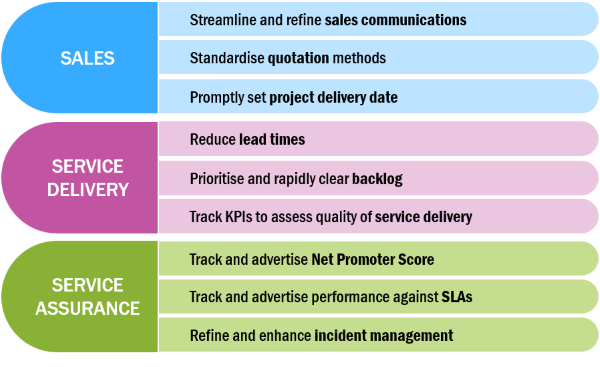Customer care is the key opportunity to differentiate fixed services for large enterprises

Fixed connectivity demand is saturated in high-income markets, forcing operators to compete on price, thereby reducing value and putting pressure on revenue streams. Connectivity consists of many different elements, some of which are hard to differentiate (such as the fibre itself). However, "even if the physical product is a commodity, other activities can often lead to substantial differentiation".1 Operators should focus on areas where differentiation is possible, such as service and support – these are elements that we know enterprises value beyond value-added features or technology.
This article is based on our strategy report, High-speed fixed connectivity for large enterprises: operator approaches to differentiation, which outlines three different approaches for operators to differentiate their fixed services. This article summarises the first and most important approach to differentiation – customer service.
Operators should seek to differentiate at all stages of the service value chain
There are three main stages in the delivery of a connectivity service and operators should look to refine their processes by targeting several KPIs at each stage (Figure 1). In many ways, the most important step that operators can take is to simply track these KPIs: you get what you measure. Having the means with which to track progress is critical to providing better customer service.
Figure 1: KPIs associated with each stage of service delivery

Source: Analysys Mason
Operators have considerable scope to stand out from the earliest stages of the contract in order to drive interest from customers
Enterprises often receive poor service from the very beginning of a sale. Inaccurate quotes or excessive quote iterations can lead to dissatisfaction. Operators should make use of tools and cloud communication platforms to streamline and enhance sales communication and quotation methods. There is also a clear financial incentive for operators to refine sales processes; better sales initiatives can lead to an increase in the number and speed of sales.
For example, Verizon has implemented tools for network design and for the generation of quotations, contracts and proposals, which integrate with each other to automate much of the sales and quotation process. These tools can help both network engineers and sales staff. Verizon reports a reduction in the cycle times of these processes of 50% once using these tools.
Poor service delivery is a common problem in the industry and can be improved through simple measures
Excessive lead times and backlogged orders can harm customer satisfaction; operators should continually review their service delivery processes to find ways to refine and improve service delivery.
For every scenario, such as if the premise is currently on-net or off-net, operators should have standardised guidelines on lead times and should look to continually refine these. Colt aims to constantly improve its service delivery processes to reduce lead times, placing more work in parallel (such as internal and external fibre works) than in sequence. Its Net Promoter Score (NPS) for service delivery has improved by almost 20 points, from 27 in 2015 to 45 in 2017.
Communication is a fundamental driver of satisfaction and a core facet of service assurance
High customer satisfaction is a strong differentiator, particularly in saturated markets.
Communication is perhaps the most important part of service assurance, and operators should be proactive in communicating both successes and failures to customers. Operators should inform customers of faults, highlight the steps that will be taken to address the problem and provide an estimated resolution time. For incident management, the initial response time and the management of customer expectations may be the most important ways to keep customers satisfied.
Conversely, when operators’ networks have performed above SLA standards they should communicate this to customers to drive awareness and boost satisfaction. This can be done via monthly network performance reports or through a portal that allows customers to track KPIs in real time.
Operators should regularly survey their clients regarding satisfaction with their services for the following two fundamental purposes.
- To enhance communication between operators and enterprise customers.
- To gain visibility and insight into the main drivers of satisfaction and how services can be improved.
Operators should focus on the basics of customer service to improve satisfaction
Operators should work hard to show that connectivity is not a commodity and that their fixed services are differentiated. There are numerous, sustainable bases for differentiation around aspects of customer care, integration with ICT services and making use of technological developments; however, enterprises value the basics of customer service far beyond value-added services and features, and there is considerable room for operators to improve their customer service and use this as a strong differentiator.
Analysys Mason is helping a number of clients to develop their enterprise strategies, both through our published research and through consulting projects. For further information, or if you wish to discuss this further, please contact Terry van Staden (Research Analyst) at terry.vanstaden@analysysmason.com or Tom Rebbeck (Research Director, Enterprise and IoT) at tom.rebbeck@analysysmason.com.
1 Quote from Michael Porter's "Competitive Advantage", 1985.
